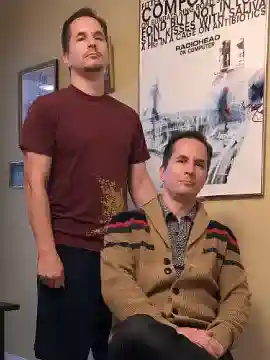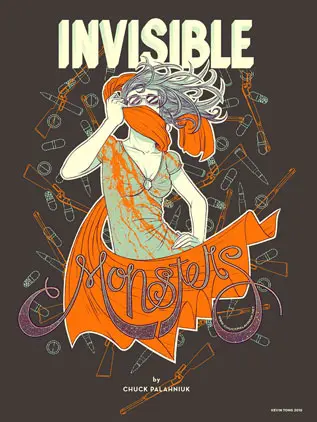This is it, fans of transgressive transgender madness, the moment you've all been waiting for. The debauched gods of literature have heard your prayers and your RLE (Remix-Less Existence) is about to come to an end. That's because this month sees the release of a radically refashioned 'director's cut' of one of your favorite Chuck Palahniuk novels.
I'm sure most of you know the backstory, but for those who don't, I'll be cribbing from my own biography of the man.
Jump to Tom Spanbauer's writers workshop, in which Chuck wrote his first novel, If You Lived Here, You'd Be Home Already. The 700-page monster was his attempt at emulating Stephen King, and was rejected by publishers across the board. Unfazed, Chuck decided to dabble in even darker material. The result was Manifesto, a story about a model with a shot-off face which would go on to become Invisible Monsters.[1]
Jump to the preface of Invisible Monsters Remix. Chuck describes how the initial draft of the manuscript was inspired by fashion magazines and written while watching MTV.
The story would not unspool as a continuous linear series of "and then, and then, and then's..." At the end of the first chapter, the reader would be directed to jump to, for example, Chapter Thirty. At the end of Chapter Thirty, she'd be told to jump to Chapter Sixteen. Following the plot would mean paging forward and backward, and you'd never know where the story might end.
As with If You Lived Here, agents just couldn't embrace the dark tone in Chuck's work, and while his voice as a writer got some recognition, nobody was willing to take a chance on him or his crazy book. [1]
That's when he wrote Fight Club, his two-handed, Twin Tower flip-off to the publishing industry. The rest, as they say, is dollar signs and history. Ka-ching! After the success of Fight Club and its follow-up, Survivor, Invisible Monsters was a no-brainer. It was released as Palahniuk's third novel, in paperback only, although by that time the chapter-jumping nature of the original had been (reluctantly) abandoned.
The book quickly became a fan favorite, and those fans have been clamoring for a hardcover edition ever since. Jump to twelve years later, and they are finally getting their wish. But in typical Palahniuk fashion, there's a twist.
...the publisher, W. W. Norton, suggested producing a hardcover version of the book, and I saw my chance. The Brandy Alexander Witness Reincarnation Program. I told myself: Here we go again.
So what's new (old?) and different? According to the PR copy, Remix is injected with new material and special design elements that fulfill Chuck's original vision for the novel. Laced in are new chapters of memoir and further scenes with the book's characters. Color me intrigued, which is probably some shade of Plumbago blue. It had been a while since I'd visited Ms. Daisy in the hospital, so I cracked the spine of Invisible Monsters for the first time in over ten years and then cued up the Reeeeeeeee-mix!
THE STRUCTURE
Chuck originally intended for Invisible Monsters to be something you could get lost in, like a fashion magazine or casino floor or the Sears catalog. Constantly jumping from chapter to chapter, never knowing how many pages you had left to read. And Remix does achieve the desired effect. Even having just re-read the original, it added a looseness to the narrative flow that I imagine would be disorienting for the first-timer. It's an interesting choice that adds another temporal layer to an already non-linear story. At the end of the preface, you are politely asked to jump to chapter forty-one, after which you are sent all the way back to chapter one, which is technically the second chapter of the original book. You then proceed to ping-pong back and forth between front and back, alternately ascending and descending a chapter at a time until you wind up smack dab in the middle with a gaping shotgun wound. Along the way you get tantalizing glimpses of new material, fueling your anticipation as you wonder how those chapters will be incorporated into the story.
Turns out, they never are. I made it through the entire book without so much as a revised sentence. It was like a typographical Waiting For Godot. I thought back to the preface, in which Chuck wrote, you might mark every page with a little X, like leaving a trail of breadcrumbs, to make sure you read them all. I should have realized that was a hint. So I started from the top and followed all the 'Jump To's', making a note of every chapter I'd read. When I reached the end of the book on page 133 and looked at my list, I had found the missing chapters.
NEW MATERIAL
It was at this point I noted that Invisible Monsters Remix is like the Navidson house in House of Leaves: It's bigger on the inside than it is on the outside. The original printing of Invisible Monsters is 297 pages long. Remix is only 301 pages, yet it has a brand new introduction and ten chapters worth of new material. What gives?
I compared chapters, pages, font size, line spacing- even kerning. Turns out, Invisible Monsters is actually only 286 pages long, because the book proper starts on page eleven. Remix is 301 pages, and the preface isn't included in that count, so that leaves us with fifteen pages of new material spread over ten chapters. Those chapters fall into three categories: misremembrances of the characters' favorite movies, anecdotes from Chuck on the writing of Invisible Monsters, and 'where are they now' coda scenes featuring Daisy St. Patience, AKA Shannon McFarland. Each of these chapters are scattered throughout the rest of the book, and each grouping is a self-contained Ouroboros with no definitive beginning or end.
Did I mention some of the chapters are printed in mirror image? From page 104:
If you're an old person, older than, say, twenty-two, you're going to hate these backwards parts you're forced to read.
Yup. Count me amongst the old and crotchety. I do most of my reading on the subway or in bed. And since I don't carry a compact and I don't have a mirrored ceiling in my bedroom, that meant waiting until I got home from work or dragging myself out of bed and holding the book up to the bathroom mirror to be able to read them. Chuck does give a thematic justification for this, but... get off my lawn!
THE VERDICT
If the original manuscript of Invisible Monsters (what we are now calling the Remix) had been released back in 1999, would the book have been as popular? Or would the leap-frog nature of it have turned people off? It's hard to say. The structure of Invisible Monsters is non-linear to begin with; the only real difference is the shuffling of the chapters (is there such a word as chapteration?), which a lot of people might consider an annoying gimmick. And the extra chapters are just that: extras. They are like bonus features on a DVD of your favorite movie. It's nice to have them, but they probably wouldn't work if inserted back in.
If I had known this up front, I probably would have only read the extras, because I had just revisited the original. Better yet, I might have read Remix in sequential chapter order, front to back, creating a whole new version of the story in the process. I think that's a way more interesting experiment, and definitely adds to the re-read value of the book. I'm actually gonna go back and do that.
Overall, this makes a great companion piece to the original, especially for those who've worn away the binding on their paperback. I could give or take on the structure, but the new materials are definitely worth a gander. The movie remembrances are fun, as are the glimpses into Daisy's future, but the real gems here are Chuck's memoir chapters (which should come as no surprise). Each of these compact essays is a Stranger Than Fiction glimpse behind the scenes of Invisible Monsters, as well as the filming of the Choke movie adaptation. In fact, some of Chuck's anecdotes are so 'What are the odds?!?!' that he chose not to use them in the novel for fear people would find them completely unbelievable. I swear, sometimes I wonder how can one man have so many crazy stories. He must drink Dos Equis.
Anyways, I think that about covers it. Jump to the comments section and let us know what you think. Is Remix a better book? Did you like the additional materials? Was my use of the 'Jump To' device superfluous and unoriginal? Sound off like you've got a jawbone.
Get Invisible Monsters at Bookshop or Amazon
Get Invisible Monsters Remix at Bookshop or Amazon
[1] Strange But True: A Short Biography of Chuck Palahniuk

About the author
Joshua Chaplinsky is the Managing Editor of LitReactor. He is the author of The Paradox Twins (CLASH Books), the story collection Whispers in the Ear of A Dreaming Ape, and the parody Kanye West—Reanimator. His short fiction has been published by Vice, Vol. 1 Brooklyn, Thuglit, Severed Press, Perpetual Motion Machine Publishing, Broken River Books, and more. Follow him on Twitter and Instagram at @jaceycockrobin. More info at joshuachaplinsky.com and unravelingtheparadox.com.








